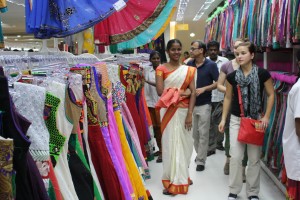A Tale of Two Markets: Insights about the Different Ways Products Reach Consumers in India
By: Sarina Zhou and Jamie Dalton, senior and sophomore in Supply Chain Management, University of Illinois at Urbana-Champaign
The following post was written by students on an ADM Institute-sponsored observation study tour through India – March 23, 2015.
During the second and third days of our trip, we visited two types of markets where the atmospheres and dynamics varied drastically. One sold agricultural products, the other sold clothes and consumer goods. The produce market we explored on the second day was filled with local vendors in close quarters, all specializing in selling different fruits, flowers, and vegetables. As a group, we were able to speak with three different vendors about their personal experiences with their products and we were able to foster close relationships with them.
The Koyambedu Market is known as the biggest wholesale market in India. Wholesale vendors receive fruits, vegetables, and flowers in truckloads each day. The vendors then sort, price, and sell products in bulk either to store owners or individuals. In this market, timing and quality play a big factor in the business’s profit and success. The vendors do not control the supply of fruits or vegetables they receive each day (this is determined by how much middlemen bring to the market), so they need to set different prices throughout the day. They start the day with higher prices due to higher demand and adjust prices throughout the day as demand decreases, as well as accounting for changes in product quality due to the day’s heat and other environmental factors. At the end of the day, the vendors’ goal is to sell everything. Interestingly, although the vendors themselves may not realize it, we can see the revenue management model being applied, a concept we have learned about as supply chain management students. Vendors are given a set amount of products to sell at the beginning of the day, but they have to adjust prices accordingly so that they are able to maximize their profit at the end of the day.
From our understanding through our conversations with the vendors, it seems that this supply chain starts with farmers. Next, there are middlemen who consolidate products from many farmers and then distribute the products to vendors. We are unsure what type of information is shared between these players in the supply chain, but we see an inherent problem in the lack of transparency and information sharing that affects every player’s profitability along the supply chain.
On day three we ventured to a seven-story mall, mainly for shopping for clothes and gifts, but we also ended up being able to compare and contrast an entirely different type of marketplace. Each floor was dedicated to different departmental needs. For example, floor two was dedicated to men’s apparel and floor three to women’s. This market was vastly different than what we had seen on the previous day, packed tightly with locals all in search for varied merchandise. Despite employees following us around trying to assist us, the intimacy we felt while in the flower market vanished into a more corporate feel. We were no longer working closely with and learning from business people who sold their products to wholesalers. Instead, we found ourselves shopping as consumers, focusing on the different merchandise in front of us. The mall complex sold products for every facet of an individual’s life: clothing, cosmetics, jewelry and accessories.

A store employee attends to a student shopping during the 2014 India study tour. Credit: ADMI/K.Wozniak
At the mall, we saw a whole new business dynamic. Every item at the store already has a set price; prices do not change throughout the day, and nothing is negotiable. While the agricultural market is business-to-business, the department store is more like the typical malls that we go to in America that are business-to-consumer. We assume that this mall receives products from either manufacturers or distribution centers. Due to the position it plays in the supply chain, this store is more customer-focused and depends on creating customer experiences for its success; for example, there were female employees in each department that would stand by us and assist us with almost everything. Despite their differences, the markets had one main factor in common: to fulfill the needs of the locals in the area. In a country that was new to us, it was important to have the opportunity to better understand where and how different markets function.
Read more blogs in this series:
Hearing from locals on farming in south India: Day 1
Things are heating up in India: Day 2
Commissioner commentary: Day 6
Farming systems in north vs. south India: Day 7
Other localized supply chains: Day 8
Reflection on stepping out of our comfort zones
Sarina and Jamie are participants in the 2015 Supply Chain Management India study abroad trip organized by the program director in the College of Business at the University of Illinois at Urbana-Champaign, Professor Udatta Palekar. Throughout the 10-day trip, students observe how agricultural products in India move through supply chains from farm to consumer with a special focus on postharvest losses.



Add Comment